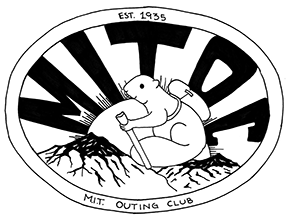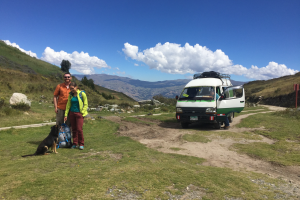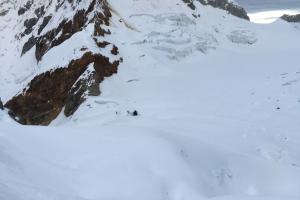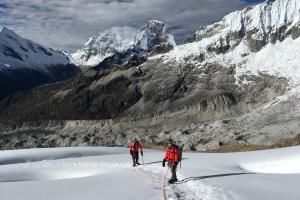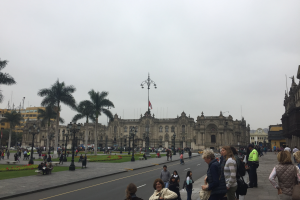Adventurer/s:
Dates of Trip:
From June 1-11, 2017, Ben Kessel, David Migl, and Ana Beglova traveled to Peru for mountaineering in the Cordillera Blanca. After acclimatizing in Huaraz and hiking to Laguna Churup (4650m), we spent several days on an attempt of Nevado Pisco (5750m), turning around at 5400 m due to altitude sickness. We spent the next couple days sightseeing and sport climbing at Hatun Machay. It was a great experience and we have a good idea of what we want to do if we ever go back.
We arrived at Lima in the evening on June 1st, took a taxi to the Plaza Norte bus terminal, and caught an overnight bus to Huaraz, where we would acclimate for the next few days at 3000m. We stayed at La Casa de Zarela, a well-known climber’s hotel with wonderful logistical support. Feeling well upon our arrival, we decided to do an acclimatization hike to the nearby alpine lake Laguna Churup (4450m). Small privately-owned vans called colectivos provide transportation for the region - they regularly run from the city to surrounding villages and trailheads, offering an inexpensive (<$5 per way) and convenient way to get around without having to rent a car. We took a colectivo to the trailhead and slowly labored up the moderate grade, but high-altitude track while enjoying our first views of the spectacular snow-covered Cordillera Blanca. A local dog came to escort us up the trail, but left after roughly an hour of not being fed. After a few hours, we arrived at the lake and enjoyed the view, a nap, and some jelly beans. David and Ben talked Ana out of trekking a couple more hours to the next lake and we descended just in time to catch the last colectivo back to town. We spent the next day resting, packing, eating strange fruits from the market, and planning for the week ahead.
After researching several itineraries, we decided to head to the Llanganuco valley for an attempt of Nevado Pisco (5752 m) in the Llanganuco valley. We also considered the Ishinca valley and Yanapaccha but decided to head to Pisco since it is a moderate glacier climb reputed to have some of the best views of the range. The Llanganuco and Ishinca valleys have huts, or refugios, near the lowest base camps, which supply food, shelter, and greatly simplify logistics if you choose to stay there, as we did. These valleys also have numerous 5000m peaks that are non-technical (besides having to rope up for the glacier). The huts and options for peaks of modest difficulty (by Cordillera Blanca standards) make these two valleys perfect destinations for a first trip to the range.
After two days in Huaraz, we spent four days and three nights in the Llanganuco valley. We took a four-hour ride on colectivos through the countryside to reach the Pisco trailhead. It was a 3h hike up a gently switchbacking trail to the Refugio Peru hut (4675m), and we made it in time for a very welcome dinner. The mountains were shrouded in clouds and we could only see the base of Pisco, but we could definitely feel the altitude as we approached the hut. After a long night of sleep, we went on an acclimation hike through the moraine field that led to the foot of the Pisco glacier (5000m.) Several entries in the guest book recommended scouting the path through the moraine the day before the climb to avoid getting lost during an alpine start. We were glad we did, as part of the route descends a loose 4th class gully with a chain for a handline, and the rest of the route meanders through loose talus before reaching the glacier. We took a GPS track and built up some existing cairns to mark the way.
By the end of the hike it was clear that we would need another rest day. On day five we rested at the hut, eating, napping, and playing cards. In the evening, the clouds cleared from the valley and for the first time we were able to see the 6000 m peaks that surrounded the valley. We spent the evening quietly taking in the views of sunset over the 6000 m peaks Huandoy, Chopicalqui, and Huascaran, enjoying the serenity in preparation for our summit push the next day.
Most parties were leaving around 1am but we wanted to give ourselves from extra time. At 11pm, after two hours of restless sleep and with plenty of Imodium readily at hand, we finally departed the refugio, saying goodbye to the staff who had not gone to sleep yet. We repeated our path from two days earlier under the light of a nearly-full moon. The night was clear and the air felt fresh and comfortable. We walked without headlamps and occasionally turned to watch the guided parties making their way down the chain descent behind us. By the time we made it to the glacier around 3:30 am, several of them had overtaken us.
We roped up and stepped onto the glacier. There was a well defined boot-pack that led from where we were standing through the wild glacier to the summit. We made our way along it very slowly. After some time it became clear that we were showing signs of mental confusion as well as moving much slower than the other parties on the mountain. For a while the terrain was fairly easy, but eventually we came to steeper terrain where we were seriously concerned about whether the team was in a suitable state to continue and whether there would be time to summit before the snow began to soften. After regrouping to take in the views and consider our options, we decided to retreat around 5400m and 7am.
We made our way back down to glacier, taking time to enjoy the sweeping vistas and incredible scenery that was being revealed by the rising sun. We descended to the refugio to repack our bags and eat a hot meal, then finally to the road. Searching for a colectivo, we were fortunate to find a tour bus to that took us all the way back to Huaraz and the Casa de Zarela which had a room showers and food for us.
Day seven was a much needed rest day. David dealt with his internal (intestinal) demons while Ana and Ben visited a local Incan ruin and a hot spring bath, which turned out to be a large swimming pool filled with lukewarm, brown water. We had only one day left in the Andes, and decided to make arrangements to spend it rock climbing at Hatun Machay, one of the best sport climbing destinations in Peru.
For about $100 USD we were able to rent all of the equipment for the three of us and hire a taxi for the full day to take us to Hatun Machay. Recently a disgruntled manager had chopped many of the bolts on moderate routes but we managed to find some excellent sport climbing at a crag on the far side of the area. The difficulty starts at about 5.10a and climbing at 4200m is definitely more difficult than climbing at sea level. We enjoyed the great views and interesting pockets and slopers that were very different from the areas we usually climb in NH. After a good day of climbing we took our private taxi (now full of hitchhikers) back to Huaraz and enjoyed a shower and meal before catching our bus back to Lima. During our final day in Lima we enjoyed impressive colonial architecture, a street festival, a luxurious meal adjacent to the ruins of a pre-Incan pyramid, and a persistent fog typical of Lima, and returned on an overnight flight the next day.
Even though we didn’t summit, we enjoyed our trip and all came away having learned something. We became more familiar with how we perform at altitude, how long it takes to acclimate, and gained a newfound respect for how exponentially difficult mountaineering becomes at high altitude. We became familiar with the logistics and are we are willing to share logistics beta with anyone considering a trip to the range. Overall, the Cordillera Blanca offers good weather, easy logistics, a low cost of living, and a variety of mountaineering routes, making it a compelling option for those considering an intermediate mountaineering or alpine ice climbing trip. If one can find inexpensive flights, the cost of the trip will be equal to or less than a trip within the continental US. The area surrounding Huaraz offers opportunities for rock climbing, cycling, and trekking for acclimatization. The main challenges are the high altitude of the region. In the future we would allow more time for acclimatization - at least 2 weeks for 5000 m peaks, and three weeks if attempting a 6000m peak. Ideally people should have glacier travel and high altitude experience - doing one of the cascade volcanoes would be a great prerequisite. Lastly, we’d like to extend our gratitude to everyone who has made MITOC such a great place to meet people and learn mountaineering skills, and to thank the Collier Adventure Grant committee for supporting our trip!
